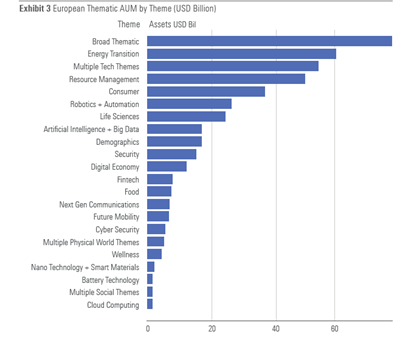Thematic funds are essentially exchange-traded funds and mutual funds that attempt to harness secular growth themes. These could be technology themes like artificial intelligence, or physical world themes like renewable energy or climate change.
They’ve actually existed since the middle of the last century; however, for decades they represented only a tiny fraction of the total global equity fund universe in number and size. Only in the last five years have we have seen thematic funds seriously attract assets on a global level, with the growth registered in the wake of the global pandemic being nothing short of spectacular.
Thematic funds have tripled their share of global equity fund assets to 2.9% in the 10 years to mid-2022, with Europe currently being the largest market accounting for 55% of global thematic fund assets. Strong performance, persistently high inflows, and an abundance of new launches powered the rapid growth.
How Should We Categorise Them?
The mushrooming of ever-more-niche and complex investment strategies from asset managers has increased the demand for greater clarity in a rapidly evolving space. At a high level, Morningstar breaks down the funds into the following classifications.
- Broad Thematic (includes funds which can invest in a broad range of themes such as future trends and smart industries);
- Physical World (topics such as green energy and logistics transportation);
- Social (topics such as post-coronavirus, wellness, and political);
- Technology (artificial intelligence, blockchain, and battery technology).
When we look at the European market, Broad Thematic funds make up the most popular theme grouping by assets.

The booming popularity of ESG in Europe has also spilled over into the world of thematic investing. In late 2020, the promise of huge government spending plans announced by the incoming Biden administration in the US prompted massive inflows into funds with an energy transition theme.
Despite a subsequent drop in net flows, funds seeking to profit from the transition away from hydrocarbon-based energy sources, such as alternative energy funds, have risen to become the second-most popular theme grouping in the region.
Popularity Won’t Guarantee Performance
Despite all of the enthusiasm for thematic funds, it’s important to keep things in perspective.
Historically, thematic funds have struggled to survive and outperform global equity markets over longer periods, and the concentrated nature of these strategies tends to cause higher volatility returns. Investors need to be careful.
When we look at data up to the end of the last year (2021), more than half of the thematic funds in our global universe both survived and outperformed the Morningstar Global Markets Index over the trailing three years.
However, thematic funds’ success rate drops to just one in 10 when we look at the trailing 15-year period. More than three quarters of the thematic funds available to investors at the onset of that period have since been closed. It is worth noting that, while a fund can close for many reasons, rarely does a fund close when it has been performing well.
Identifying Opportunities
The proliferation of thematic funds, while offering a vast array of choice, has increased the demand for clarity amongst investors trying to make sense of the waves of products coming to market. Until now, there hasn’t been a tool allowing investors to perform direct peer analysis.
Morningstar has developed a thematic funds dataset that meets this need by allowing users to easily track assets and asset flows, and analyse fund details for one or more investment themes. Going through our universe of more than 100,000 mutual funds and ETFs, we’ve identified and grouped thematic funds, into searchable Broad Themes and Themes. Users can isolate all funds that track a given theme, such as cybersecurity, or demographics at the click of a button.
By mapping the thematic fund universe, Morningstar is helping users cut through the noise and make more informed investment decisions. Users can now quickly identify and conduct direct peer comparisons between funds claiming to pursue similar thematic strategies.
To learn more about Thematic Funds and how Morningstar’s data sets can help identify opportunities, the following resources are free to download:
